| FLATBED SCANNERS |
 |
|
Flatbed scanners are used to create digital copies of original paintings, documents, drawings, photographs, and film negatives. This article discusses the origins and workings of flatbed scanners, as well as the qualities that differentiate different models and their results. Finally, we present a comparison of different consumer and professional flatbed image scanners.
|
SUMMARY
| WHAT IS A FLATBED SCANNER? |
OTHER SCANNER TYPES |
QUALITY FACTORS |
FLATBED SCANNER COMAPRISON |
| Flatbed scanners create a digital image of an object - usually 2-dimensional - that is placed on the glass of the scanner surface. |
- Drum scanners
- Handheld Scanners
- Smartphone scanner apps
|
- Size of digital image
- Color quality compared to original
- Density range of shadows/highlights
|
- Lower price-range, consumer scanners
- Top quality professional-grade scanners
|
|
| WHAT IS A FLATBED SCANNER?
|
 |
|
A flatbed scanner is perhaps the most common type of image scanner on the market today. Many private households have a small flatbed scanner next to their computer; it may be attached to the printer, or a separate device.
Flatbed scanners are made up of a plate of clear glass, on which the object sits while a beam of light - usually xenon - passed across the face of the image. Depending on the style, and location of the light, the object may be placed facedown or faceup on the glass. The speed of the scan - of the light passing across the surface of the object, depends on the size of the object and the quality of scan required.
These versatile devices range from the small, 18 x 30" desktop models intended for single sheets of paper (or at most a textbook) to enormous tables capable of scanning 33 x 47" objects many feet deep.
HISTORY OF THE SCANNER
Today's image scanners developed out of the fax machines and telephotography devices of earlier generations.
The first such machine was the pantelegraph of the 1860s, an early facsimile machine that used pendulums to scan and transmit images across telegraph waves. This early scanner was capable of sending visuals of handwriting and drawings up to 4x6" in size.
The Belinograph, invented in 1913, used a photocell within a rotating drum to scan color photos. The process was very complex, however, and the cost of transmitting images was high.
|
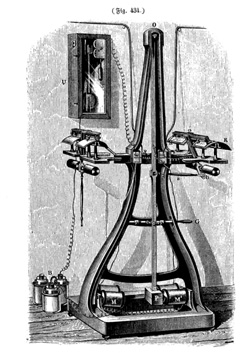
Pantelegraph maching, circa 1860
|
| BRIEF OVERVIEW OF OTHER SCANNERS
|
 |
Drum Scanners
Using photomultiplier tubes (PMTs), a drum scanner records an image of an object mounted on a cylinder. The scanner, which surrounds the cylinder, spins rapidly to record the image. Most styles available today utilize three PMTs - one for each of the primary colors of light (red, green, blue).
Hand Scanners
The bar of light is affixed to a handle which is held in the user's hand and dragged across the surface of the object being scanned. Two types of hand scanners exist: document and 3-dimensional. A steady hand is required to move the scanner across the object in a smooth motion at a uniform speed.
Smartphone Scanners
Most recently, applications for smartphones have been developed which allow the user to scan using their phone camera. After a photograph is taken of the document, the app will account for curvature due to the angle of the lens, automatically correct color to minimize shadow, and correct other differences born of taking a photo rather than scanning. Different apps are suited to document scanning or photograph scanning.
|
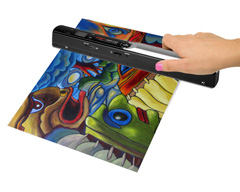
Hand scanner
|
| FLATBED SCANNERS: QUALITY
|
 |
Depending on the model, a flatbed scanner can product anything from a grainy, black and white image to a high quality, high resolution reproduction of an original painting or photograph.
SIZE/RESOLUTION
Today, relatively basic, low-cost scanners are capable of creating digital images up to 2400 d/ppi (dots/pixels per inch). The higher the dpi, the larger the image can be reproduced without losing detail, or pixelization. An image scanned at 300 dpi will result in a quality reproduction of the same size as the original, while an image scanned at 1200 dpi can be reproduced well at four times the size of the original.
COLOR
The color quality of scanned images depends on the quality and type of light source used. Most scanned images need to be digitally altered in order to match the original colors, but the higher the scanner's quality, the less touch up required.
Color in scanners is measured in "bits", and will produce images with between 24 and 48 bits of color depth. The color depth has to do with the sensitivity of the sensors that are recording the image.
DENSITY RANGE
This qualifier refers to the shadow and brightness that can be accurately represented by the scanner, and for 2-dimensional objects it is most important for scanning film negatives. Density is measured within a range of 0 to 5: the Dmax and the Dmin. Scanners with a low dynamic range (around 2.0d) should not be used to scan film negatives or textured objects, and are mainly intended for document scanning.
Flatbed scanners in the $250 range may have a Dmax as high as 3.4d, which makes them suitable for scanning all 2-dimensional objects.
Other considerations for flatbed scanners include:
- Maximum document thickness (paper vs plaster or wood-mounted artwork)
- Speed of the scan (ranges from a few seconds to many minutes for higher resolution/larger artwork)
- Maximum scan bed size, though object can be scanned in multiple sessions and "stitched" together digitally
- Image clean up software included with the program, to fix dust spots and other physical flaws
- Interpolated resolution: in addition to the optical resolution discussed above, the scanner or software can add pixels to make the digital image larger. Quality is generally reduced when interpolated resolution is used.
|
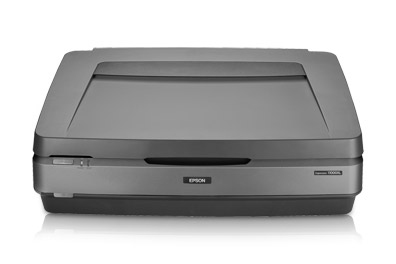
Epson 11000XL, used by KeenART Media
|
| FLATBED SCANNER MODEL COMPARISON
|
 |
As you can see from the list below, flatbed image scanners are available in a wide range of sizes and prices. Which scanner you require will depend on the medium of the object you are scanning, the quality required, and what you plan to do with the image once it is rendered (ie: digitally alter, straight-to-print, etc).
CONSUMER SCANNERS
Canon CanoScan LiDE120 Color
Price: $80
- Type: Desktop
- Max size: 8.5x11"
- Max optical dpi: 2400x4800
- Color depth: 48-bit
Epson Perfection V600 Photo Scanner
Price: $200
- Type: Desktop
- Max size: 8.5x11.7"
- Max optical dpi: 6400
- Color depth: 48-bit
Plustek OpticPro A320 Tabloid
Price: $470
- Type: Desktop
- Max size: 11x17"
- Max optical dpi: 1600
- Color depth: 48-bit
PROFESSIONAL SCANNERS
Epson WorkForce DS-50000
Price: $1600
- Type: Desktop
- Max size: 11.7x17"
- Max optical dpi: 600
- Color depth: 16-bit
Epson E11000XL-GA Photo Scanner
Price: $2200
- Type: Desktop
- Max size: 12.2x17.2"
- Max optical dpi: 2400x4800
- Color depth: 48-bit
Cruse brand Scanners
Price: $50,000-175,000
- Type: Self-standing
- Max size: up to 80x100"
- Max optical dpi: up to 600
- Color depth: 48-bit
|
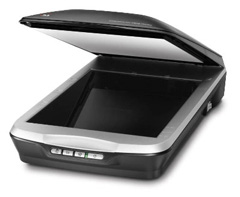
Epson V600 scanner
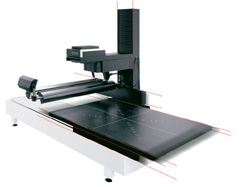
Cruse scanner
|
|
At KeenART Media, we offer artwork scanning for your original paintings, drawings, prints, photographs, and other 2-dimensional art objects. We use high quality Epson scanners for our reproductions, and color match each image with the original.
If you have questions about this service, or any of our other services or products, don't hesitate to contact us. Our knowledgeable staff is always happy to assist with answers, advice, or suggestions.
|
|

|



|
USA Giclee On Canvas, Fine Art Printing - Art Scanning & Reproductions - Handmade Oil Paintings - Custom Wood Panels, Metal Picture Framing - Block/Plaque Mountings, Large Format Dry Mounting & Lamination - Art Supplies: Stretcher Bars, Cradled Wood Panels and Artist Canvas - Collages On Canvas - Plexi/Acrylic Face Mounts - Block Acrylics, Fabric Printing, Dye Sublimation - Cityscape Skyline Prints, Resin, Photo Gifts and more...
|
|
© 2002-2025 - KeenART Media Ltd.
|
|
| |
|
